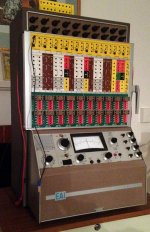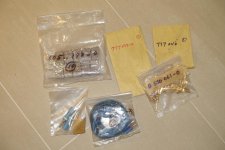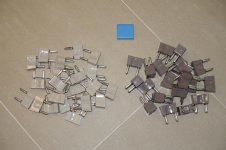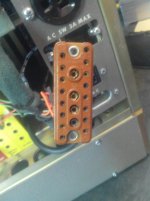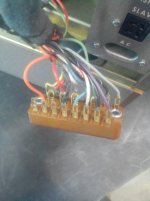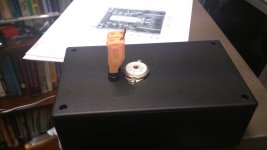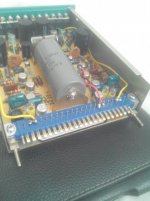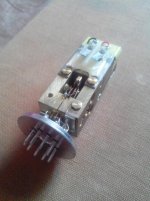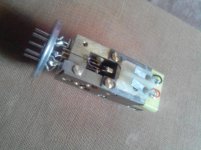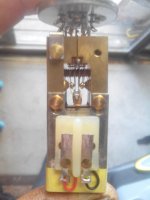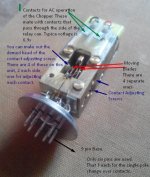inotarobot
Veteran Member
Hi all,
As some of you will know in November, I bid on eBay and won a EAI TR-20 Analog computer.
After a long interstate drive (12 hrs each way) in early December, to pick it up, its finally home.
I transported it on the back seat of my family sedan; a SAAB 9.5. It was wrapped in blankets to protect it, and sat on a padded sleeping bag as an extra protection against road bumps. Mind you the interstate highway I traveled on, often at 110km/hr was very smooth.
The only jarring it may have got, was when I drove the 80m up the 20deg angle gravel driveway, correction creek bed, at home. Just need $20,000 , as quoted by earthing moving civil contracting companies to fix my driveway.
On actually seeing the TR-20 for the first time in Adelaide, I was quite thrilled. It is in mint condition. The seller, a charming gentleman, took the time to show me it running and also explained a lot about it. During that brief power up all, he pointed out all the overload lights toggling then going out. We did not do any other functional tests.
It was around 9pm and in hindsight, I should have just gone to a motel after the long drive, and then gone the following morning to pick it up; as I would have had more time and focus to take in the information I was being shown. Also I think I would have had more power on time to get familiar with the unit. That way I would have had a better reference point, to know if any future power on issues or possible damage could have been caused by my chosen method of shipping.
Finally a few days ago, I actually got some time to focus on the TR-20.
1. Put power to it and ended up will more than 50% of the overload lights on.
2. Powered it of. Removed and then re-seated front panel, after checking the contacts, found all are like new, and none bent.
3. Next power up and most of the overload lights went out. Just had three hard on, and one flickering. +10v and -10v rails are ok on Fluke multimeter.
4. Did the amp balance check, 14 passed Ok
5. Checked amp outputs with feedback block in. 11 were at zero volts, 9 were reading +15v
6. Ran each of these 11 Ok amps from step 5, in Inverter mode, first with +10 then with -10v. 8 passed. 3 failed.
So in summary it seems I have only 8 good amplifier's to start.
Faulty one are 1,2,4,11,12,13,14,15,17,18,19,20
Planning over Christmas to have some time to test amps.
Bought some 22 pin single row connectors to make both an extender and also a separate bench test unit.
Looking forward to doing my first calculations on it.
The unit also came with a full set of patch leads, manuals and some spares, but no spare Coppers.
Now I want to buy or find or be GIVEN (LOL) a matching HP plotter.
As some of you will know in November, I bid on eBay and won a EAI TR-20 Analog computer.
After a long interstate drive (12 hrs each way) in early December, to pick it up, its finally home.
I transported it on the back seat of my family sedan; a SAAB 9.5. It was wrapped in blankets to protect it, and sat on a padded sleeping bag as an extra protection against road bumps. Mind you the interstate highway I traveled on, often at 110km/hr was very smooth.
The only jarring it may have got, was when I drove the 80m up the 20deg angle gravel driveway, correction creek bed, at home. Just need $20,000 , as quoted by earthing moving civil contracting companies to fix my driveway.
On actually seeing the TR-20 for the first time in Adelaide, I was quite thrilled. It is in mint condition. The seller, a charming gentleman, took the time to show me it running and also explained a lot about it. During that brief power up all, he pointed out all the overload lights toggling then going out. We did not do any other functional tests.
It was around 9pm and in hindsight, I should have just gone to a motel after the long drive, and then gone the following morning to pick it up; as I would have had more time and focus to take in the information I was being shown. Also I think I would have had more power on time to get familiar with the unit. That way I would have had a better reference point, to know if any future power on issues or possible damage could have been caused by my chosen method of shipping.
Finally a few days ago, I actually got some time to focus on the TR-20.
1. Put power to it and ended up will more than 50% of the overload lights on.
2. Powered it of. Removed and then re-seated front panel, after checking the contacts, found all are like new, and none bent.
3. Next power up and most of the overload lights went out. Just had three hard on, and one flickering. +10v and -10v rails are ok on Fluke multimeter.
4. Did the amp balance check, 14 passed Ok
5. Checked amp outputs with feedback block in. 11 were at zero volts, 9 were reading +15v
6. Ran each of these 11 Ok amps from step 5, in Inverter mode, first with +10 then with -10v. 8 passed. 3 failed.
So in summary it seems I have only 8 good amplifier's to start.
Faulty one are 1,2,4,11,12,13,14,15,17,18,19,20
Planning over Christmas to have some time to test amps.
Bought some 22 pin single row connectors to make both an extender and also a separate bench test unit.
Looking forward to doing my first calculations on it.
The unit also came with a full set of patch leads, manuals and some spares, but no spare Coppers.
Now I want to buy or find or be GIVEN (LOL) a matching HP plotter.

